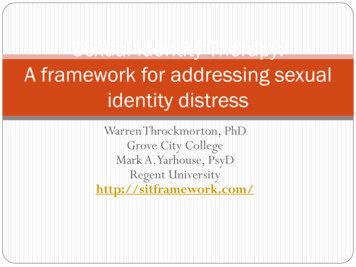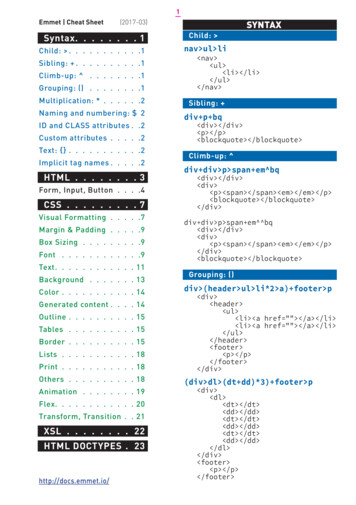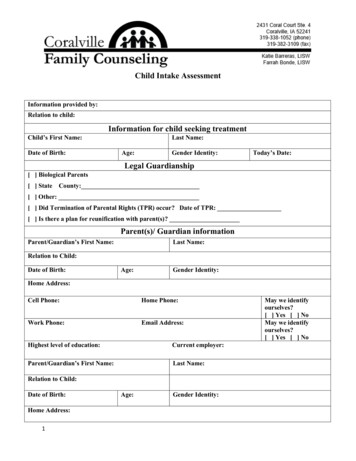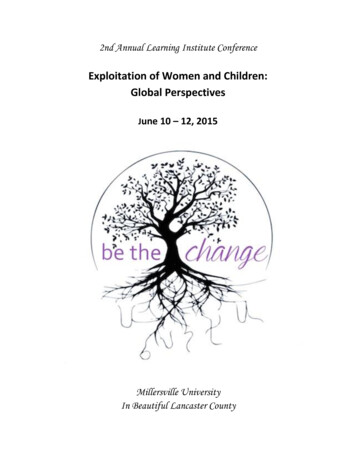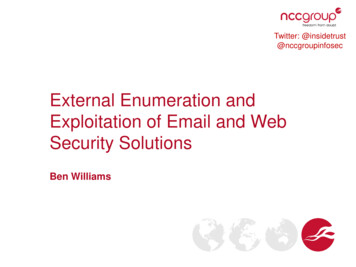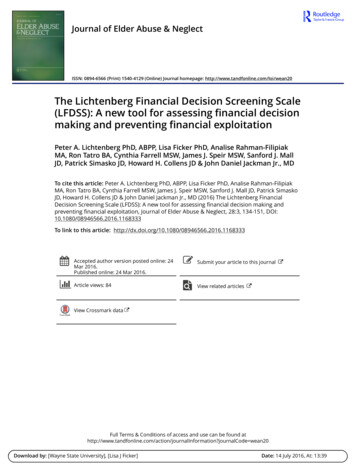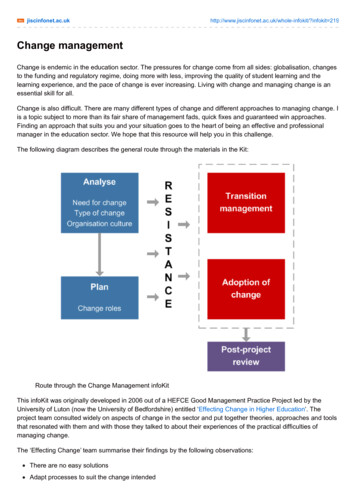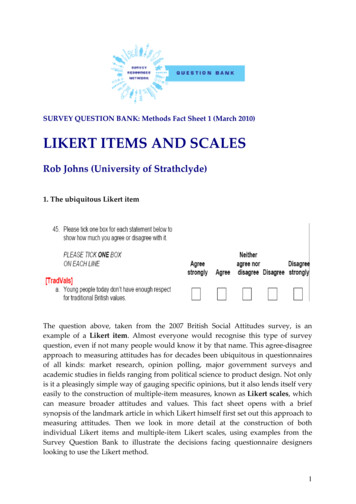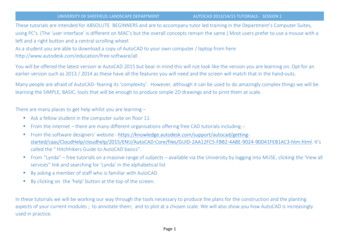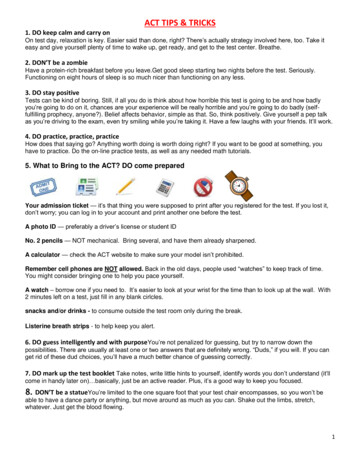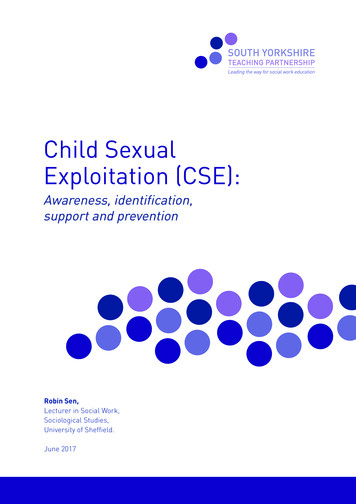
Transcription
Child SexualExploitation (CSE):Awareness, identification,support and preventionRobin Sen,Lecturer in Social Work,Sociological Studies,University of Sheffield.June 2017
ContentsIntroduction3Part 1: Awareness and identification4Reflective exercise 1: Thinking about your role41. Defining CSE and its key features4Box 1: Key terminology in this resource62. The Law and CSE6Box 2: Estimates of prevalence8Box 3: Harmful effects93. Perpetrators and victims10Reflective exercise 2: Victims and perpetrators11Reflective exercise 3: Peer to peer sexual exploitation13Box 4: Looked After Children and CSE15Reflective exercise 4: Reflections so far15Part 2: Supporting children and young people at risk and subject to CSE161. Engaging and supporting young people and families16Reflective exercise 5: Tackling CSE: Some tips for direct work192. Developing a broader CSE prevention strategy20Summary and key messages21References and resources222 Child Sexual Exploitation (CSE)
IntroductionResearch review and practice resourceChild Sexual Exploitation (CSE) is a pressingchild welfare issue. Over the last 15 years ithas received a good deal of media attention,and there have been significant research,policy and practice developments. As a largelyhidden phenomenon it is not possible to knowthe prevalence of CSE with certainty and itoften raises difficult issues around the balancebetween respecting children/young people’srights to choice and agency and the need toensure their care and protection. Consequently,CSE poses challenges for professionals,organisations and communities seeking to bothsafeguard child welfare and promote children/young people’s rights.Following the arguments of the Munro Reviewof Child Protection (Munro 2011), a key themein this resource is good practice in the area ofCSE, as others, requires professional curiosityand effective professional judgement ratherthan merely following routine procedures,however good those procedures might be.One of the key ingredients underpinningsound professional judgement is reflexivity –the ability to reflect on our own thinking andactions. This in turn requires us to identify theassumptions underpinning our beliefs, questionthe evidence for them, and consider how theyhave influenced us to arrive at a particularunderstanding or course of action.This resource has primarily been produced forchild, youth and family practitioners workingwithin children’s social care services inEngland who have key roles and responsibilitiesin relation to child welfare, child protection,family support, disabled children/youngpeople and Looked after Children. However, allmembers of society have a role in preventingand tackling CSE and the resource may haveuse for a broader audience seeking to betterunderstand the nature and prevalence of CSE inthe UK, and the key features of current Englishlaw, policy and practice in respect of CSE. Theresource has two main parts which respectivelyfocus on: 1) Awareness and identification; and2) Support and prevention in respect of CSE.About the authorRobin Sen practised as a local authoritychild and family social worker in Glasgowand he also undertook communitydevelopment work there. His teachingand research have been in the areasof child protection social work, familysupport and children in out of home care.South Yorkshire Teaching Partnerships 3
Part 1: Awareness and identificationReflective exercise 1: Thinking about your role andresponsibilities in regard to CSE in pairs with someone elsefrom your teamFirstly by yourself1. Identify your individual responsibilities in respect of CSE and how these fit with yourteam’s responsibilities around CSE.2. What would you do if you had concerns about CSE in respect of a child/young person?3. Whom would you discuss it with inside your team? Would you discuss it withanyone else outside your team? Name who these people are.Secondly in pairs with someone else in your team4. Compare your answers with a colleague – are there any surprises in either of yourresponses?5. If you are unclear about anything in points 1-3 discuss with your colleague and developa list of what you each need to find out about and how you will find out about it.1. Defining CSE and its key featuresThere are a number of different definitionsof CSE with no agreed definitive one. TheGovernment has recently released a newdefinition of CSE as follows (DfE 2017: 5):Child sexual exploitation is a form of childsexual abuse. It occurs where an individualor group takes advantage of an imbalanceof power to coerce, manipulate or deceive achild or young person under the age of 18 intosexual activity (a) in exchange for somethingthe victim needs or wants, and/or (b) for thefinancial advantage or increased status ofthe perpetrator or facilitator. The victim mayhave been sexually exploited even if the sexualactivity appears consensual. Child sexualexploitation does not always involve physicalcontact; it can also occur through the use oftechnology.This replaces the previously, widely cited,government definition included in the guidance4 Child Sexual Exploitation (CSE)Safeguarding Children and Young People fromSexual Exploitation (DCSF 2009). This statedthat:Sexual exploitation of children and youngpeople under 18 involves exploitative situations,contexts and relationships where youngpeople (or a third person or persons) receive‘something’ (e.g. food, accommodation, drugs,alcohol, cigarettes, affection, gifts, money) asa result of them performing, and/or another orothers performing on them, sexual activities.Child sexual exploitation can occur through theuse of technology without the child’s immediaterecognition; for example being persuaded topost sexual images on the Internet/mobilephones without immediate payment or gain.In all cases, those exploiting the child/youngperson have power over them by virtue of theirage, gender, intellect, physical strength and/or economic or other resources. Violence,coercion and intimidation are common,
involvement in exploitative relationships beingcharacterised in the main by the child/youngperson’s limited availability of choice resultingfrom their social/economic and/or emotionalvulnerability (DCSF 2009: 9).A number of points arise from consideringthese definitions regarding the nature of CSEas we currently understand it. Firstly, CSEinvolves sexual activity perpetrated againstchildren/ young people by those in a positionof trust, power or authority over them. Theexploitative character of CSE may exhibit itselfin different ways. It could be via explicit force- coercive sexual violence, physical violence orthreats of violence from perpetrators towardsa child/young person or their family. Often,however, the exploitation is also underpinnedby less overt coercion - manipulation throughgrooming including the provision of gifts,money and the provision of alcohol or drugsto the child/young person whereby they do notthemselves recognise or fully recognise theyare being exploited. Notably, under UK law achild/young person cannot legally consent tosexual activity where exploitation is involved,and this provision applies to young people aged16 or 17 years of age who are legally able toconsent to non-exploitative sexual activity.CSE can involve sexual abuse via direct sexualcontact but can also be perpetrated withoutdirect contact. Exploitation via direct sexualcontact includes vaginal, oral, anal penetrationand intimate touching. Non-contact sexualexploitation includes exposing a child/youngperson to sexual activity between others andthe taking and sharing of sexually explicitimages of a child/young person. The use ofimages may occur after a child/young personis persuaded to share an explicit image ofthemselves online or via a mobile phone whichcan then be shared more widely, in some cases,without the child/young person’s awareness.Exploitation via direct sexual contact andnon-contact may also co-exist – for examplea perpetrator could film and share an act ofsexual abuse perpetrated by them against achild/young person and subsequently share it.Thirdly, perpetrators of CSE can act aslone individuals or in groups. Where CSE isundertaken by groups of perpetrators, thegroups can range from looser networks ofperpetrators, who know each other alreadyand who may jointly exploit the same child/children or young person/young people, tohighly organised criminal networks purposelyestablished to engage in CSE. CSE involvingcriminal networks may involve the externaltrafficking of children/young people fromabroad into the UK, and the internal traffickingof children/young people around the country,for the purpose of sexual exploitation (Brayleyand Cockbain 2014).While it can be said that all CSE is a formof ‘child sexual abuse’, and all ‘child sexualabuse’ is exploitative, in most cases adistinction is made between the two. ‘Childsexual abuse’ tends to be used as a broaderterm which includes sexual abuse perpetratedagainst very young children, and also includessexual abuse perpetrated against children/young people by those within immediatefamily networks. In CSE the focus tends to beon sexually exploitative acts perpetrated bythose outside the immediate family network,and against adolescent young people. Currentevidence suggests that those young people 12and above are at greatest risk of CSE (Beckett2011; Brayley and Cockbain 2014). However,these features of CSE may not always holdtrue. In some cases family members in a child/young person’s network have been involvedin grooming them for sexual exploitation(Berelowitz 2013) and there is also evidencethat children as young as six have sometimesbeen subject to CSE (Chase and Statham 2005).Finally, it should be noted that there are linksbetween CSE and all forms of maltreatment.South Yorkshire Teaching Partnerships 5
Children/young people who have already beensubject to other forms maltreatment are atgreater risk of CSE (Berelowitz 2013; Flood andHolmes 2016). There appear to be particularlinks between CSE and child neglect (Floodand Holmes 2016). These links exist becauseof the cumulative impact of child neglect on achild/young person’s individual developmentand the links between child neglect and theabsence of supportive social relationships andnetworks in a child/young person’s life. Thesefactors combine to increase a young person’svulnerability to CSE (ibid.)Box 1: Key terminology in this resource If age is not otherwise specified ‘child/children’ is used to refer to those who are11 years of age and younger, while ‘young person/young people’, ‘young woman/youngwomen’, and ‘young man/ young men’ are used to refer to those who are 12-17 yearsold. Child/young person is used when referring to those aged 0-17. It is worth notingthat while young people aged 12-17 seem to be the most common victims of CSE,those under 12 may be subject to it as well. ‘CSE’ will be used as an abbreviation for ‘Child Sexual Exploitation’ to refer to thesexual exploitation of children and young people aged 0–17. While this age group arethe focus of this resource, it is important to recognise that young people aged over18, especially young people with additional needs and disabilities, may also be subjectto sexual exploitation and that the law offers some, albeit lesser, legal protection foradults in this regard.2. The Law and CSEThis section provides an overview of the keylegal provisions connected to sexual activity,CSE and Police disruption powers in England atthe time of writing.Sexual offences and consentThe age of consent for sexual activity inEngland is 16 years for both males and femalesand it is illegal to engage in sexual activity withsomeone who is younger than this. While it istherefore illegal for two young people under16 to engage in sexual activity, Home Officeguidance suggests that where young peopleunder the age of 16, who are of a similar age,consensually engage in sexual activity, they willnot be prosecuted (FPA 2015).6 Child Sexual Exploitation (CSE)Children and young people aged twelve orunder cannot legally consent to any sexualactivity and therefore any penetrative sexualact perpetrated against someone of this age isautomatically considered statutory rape in law.The Sexual Offences Act (2003) gives specificprotection to young people aged 16 and 17, byestablishing that no-one under 18 can legallyconsent to sexual activity where exploitationis involved. Therefore, even though 16 and 17year olds are legally able to consent to sexualactivity, the law still offers them this protectionagainst sexual exploitation. Additionally, wherean adult is in a position of trust in relation toa young person (e.g. a teacher, social worker,community worker) it is illegal for that adultto engage in sexual activity with that young
person while they are under 182. So, by way ofillustration, it is illegal for a teacher to engagein sexual activity with a pupil aged 16 or 17 whoattends their school.it is now also a criminal offence for an adult tosend any sexual message via a mobile phone orsocial media to a child/young person under 16years old.When working with older young peopleapproaching adulthood, transitionarrangements for supporting them once adultsneed to be considered (Heal 2015). Children’sservices have specific legal duties to supportthe welfare of Looked after Children and youngpeople with a disability beyond the age of 18.More generally, vulnerable adults are alsoafforded potential protection against sexualexploitation via parts of the 2014 Care Act. ThisAct gives local authorities specific safeguardingresponsibilities for adults who have care andsupport needs, who are experiencing abuseor neglect, or at risk of doing so, and who areunable to protect themselves due to their careand support needs. Whether these duties willbe consistently interpreted to apply to youngadults who are experiencing sexual exploitationis as yet unclear. The wording of the Care Actsuggests this will come down to how localauthorities seek to apply the definition of ‘careand support’ needs.The Sexual Offences Act (2003) also makes itillegal to: Pay for the sexual services of a child/young person who is under 18. Cause or incite a child/young personunder 18 to be exploited through prostitutionor pornography, including the creation anddistribution of sexually explicit images ofchildren. Traffick any person (child/young personor adult) into, within or out of the UK forthe purpose of sexual exploitation.The Sexual Offences Act (2003) introduced arange of new offences relating to the groomingand sexual exploitation of children and youngpeople. These include for a child/young person16 or under: Causing or inciting them to engage insexual activity. Engaging in sexual activity in theirpresence. Befriending them in person or online withthe intent of engaging in sexual activitywith them. Meeting or intending to meet themfollowing sexual grooming, either onlineor in person.Additionally, the Serious Crime Act (2015) hasnow amended the Sexual Offences Act so thatIt is also worth noting that the Serious CrimeAct (2015) amended the Sexual Offences Act(2003) to remove previous references in this Actto ‘child prostitution’ and ‘child pornography’.This is because there have been moves overthe last 20 years to replace the previousterminology with language such as ‘children/young people abused through prostitution’or ‘children/young people exploited throughpornography’. The language shift reflects arecognition of the distinction between adultand child worlds and the abusive powerrelationships underpinning a child/youngperson’s involvement in prostitution orpornography (Chase and Statham 2005; Houseof Commons 2013). The Serious Crime Act(2015) further decriminalised ‘soliciting forthe purposes of prostitution’ for those who areunder 18. Therefore, while it is a crime for anadult to pay for the sexual services of a child/young person under 18, those under 18 can nolonger be charged by the Police for involvementin prostitution - as young people regularly wereuntil the late 1990s.The Sexual Offences (Amendment) Act 20002South Yorkshire Teaching Partnerships 7
Box 2: Estimates of the prevalence of CSE: recent data andemerging evidenceAccurately estimating the extent of CSE is difficult because of the hidden nature of theissue. Estimates of CSE prevalence come in two forms: the number of children/youngpeople reported and recorded in official terms as already being subject to CSE; andthe number of children/young people who are at risk of CSE. There are some problemswith both of these estimates. The first category is influenced by practitioner and agencyreporting and recording procedures and decisions. The second category contains greaternumbers of children/young people due to the fact CSE is known to be under-reported andunder-detected. However, estimates of numbers ‘at risk’ are influenced by interpretationsof what being ‘at risk’ means and how it is measured. They are also based on projectionsabout what might happen in the future rather than predictions of what necessarily willhappen. Bearing these issues in mind, it is nonetheless useful to consider what thecurrent scale of CSE may be thought to be.Children/young people who have experienced CSE In 2006 the Home Office (now the Ministry of Justice) estimated that approximately5,000 children and young people under 18 were affected by CSE in England and Wales,but noted this was likely to be an underestimate (McClelland and Newell 2013). Berelowitz (2013) reported that 2,409 children and young people in England werevictims of CSE by gangs and groups alone. The Independent Inquiry Into Child Sexual Exploitation in Rotherham (Jay 2014)produced a ‘conservative estimate’ that around 1,400 children and young people hadbeen subject to CSE in and around Rotherham from 1997– 2013. This number isequivalent to around 2.5% of the current number of children and young people living inRotherham.Children/young people at Risk of CSE Berelowitz (2013) identified 16,500 children and young people in England were at‘high risk’ of CSE. Beckett’s (2011) research on CSE in Northern Ireland found CSE was a ‘concern’ forsocial workers in relation to one in seven young people receiving social work supportservices. Extrapolating Beckett’s findings to England, based on the official dataindicating there were around 140,000 children and young people aged 10-17 who wereeither Looked After Children or on Child Protection Plans, this would mean that CSEwas a concern for around 20,000 children and young people. In addition to these 20,000, who might be considered to be at the highest risk of CSE,the most recent government statistics for England show that of the Children in Need(CIN) referrals that went forward for social care assessment in 2015/16, 17,600 (or3.9% of the total) identified CSE as a concern within the assessment (DfE, 2016). In total therefore, a very rough estimate is that CSE is a notable concern for close to40,000 children/young people in England currently in contact with children’s socialcare. There is additionally likely to be other children/young people who are not knownto children’s social care for whom CSE is a notable concern over and above thisestimate.It is important to note that the age category of 10-17 years is used as Government statistics for Looked After Children. For childrenand young people on Child Protection Plans the age categories for data are 10-15 years and 16 years and over.8 Child Sexual Exploitation (CSE)
Box 3: The harmful effects of CSE for children and youngpeople The possible mental health effects of being subject to sexual abuse as a child/youngperson include anxiety, conduct disorder, depression, eating disorders, low self-esteem,Post-traumatic Stress Disorder (PTSD), self-harm and suicide attempts (Glaser 2016). The potential effects on future behaviour and development include age-inappropriatesexual activity, alcohol and drug misuse, lack of ability to trust others
focus on: 1) Awareness and identification; and 2) Support and prevention in respect of CSE. About the author Robin Sen practised as a local authority child and family social worker in Glasgow and he also undertook community development work there. His teaching and research have been in the areas of child protection social work, family
